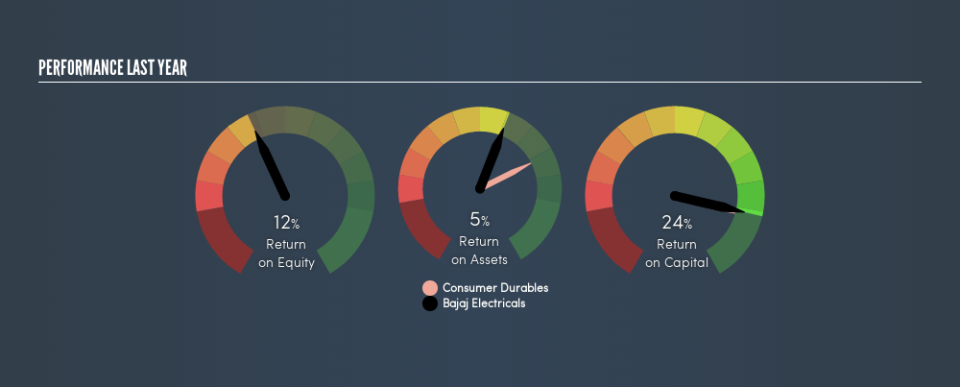Here's What Bajaj Electricals Limited's (NSE:BAJAJELEC) ROCE Can Tell Us

Today we are going to look at Bajaj Electricals Limited (NSE:BAJAJELEC) to see whether it might be an attractive investment prospect. To be precise, we'll consider its Return On Capital Employed (ROCE), as that will inform our view of the quality of the business.
Firstly, we'll go over how we calculate ROCE. Next, we'll compare it to others in its industry. Last but not least, we'll look at what impact its current liabilities have on its ROCE.
What is Return On Capital Employed (ROCE)?
ROCE is a measure of a company's yearly pre-tax profit (its return), relative to the capital employed in the business. Generally speaking a higher ROCE is better. Ultimately, it is a useful but imperfect metric. Renowned investment researcher Michael Mauboussin has suggested that a high ROCE can indicate that 'one dollar invested in the company generates value of more than one dollar'.
How Do You Calculate Return On Capital Employed?
Analysts use this formula to calculate return on capital employed:
Return on Capital Employed = Earnings Before Interest and Tax (EBIT) ÷ (Total Assets - Current Liabilities)
Or for Bajaj Electricals:
0.24 = ₹3.3b ÷ (₹52b - ₹38b) (Based on the trailing twelve months to June 2019.)
Therefore, Bajaj Electricals has an ROCE of 24%.
See our latest analysis for Bajaj Electricals
Does Bajaj Electricals Have A Good ROCE?
ROCE is commonly used for comparing the performance of similar businesses. In our analysis, Bajaj Electricals's ROCE is meaningfully higher than the 17% average in the Consumer Durables industry. I think that's good to see, since it implies the company is better than other companies at making the most of its capital. Regardless of where Bajaj Electricals sits next to its industry, its ROCE in absolute terms appears satisfactory, and this company could be worth a closer look.
The image below shows how Bajaj Electricals's ROCE compares to its industry, and you can click it to see more detail on its past growth.
It is important to remember that ROCE shows past performance, and is not necessarily predictive. ROCE can be misleading for companies in cyclical industries, with returns looking impressive during the boom times, but very weak during the busts. ROCE is, after all, simply a snap shot of a single year. Since the future is so important for investors, you should check out our free report on analyst forecasts for Bajaj Electricals.
Bajaj Electricals's Current Liabilities And Their Impact On Its ROCE
Short term (or current) liabilities, are things like supplier invoices, overdrafts, or tax bills that need to be paid within 12 months. Due to the way the ROCE equation works, having large bills due in the near term can make it look as though a company has less capital employed, and thus a higher ROCE than usual. To counter this, investors can check if a company has high current liabilities relative to total assets.
Bajaj Electricals has total assets of ₹52b and current liabilities of ₹38b. Therefore its current liabilities are equivalent to approximately 74% of its total assets. Bajaj Electricals's current liabilities are fairly high, which increases its ROCE significantly.
What We Can Learn From Bajaj Electricals's ROCE
This ROCE is pretty good, but remember that it would look less impressive with fewer current liabilities. Bajaj Electricals shapes up well under this analysis, but it is far from the only business delivering excellent numbers . You might also want to check this free collection of companies delivering excellent earnings growth.
If you are like me, then you will not want to miss this free list of growing companies that insiders are buying.
We aim to bring you long-term focused research analysis driven by fundamental data. Note that our analysis may not factor in the latest price-sensitive company announcements or qualitative material.
If you spot an error that warrants correction, please contact the editor at editorial-team@simplywallst.com. This article by Simply Wall St is general in nature. It does not constitute a recommendation to buy or sell any stock, and does not take account of your objectives, or your financial situation. Simply Wall St has no position in the stocks mentioned. Thank you for reading.

